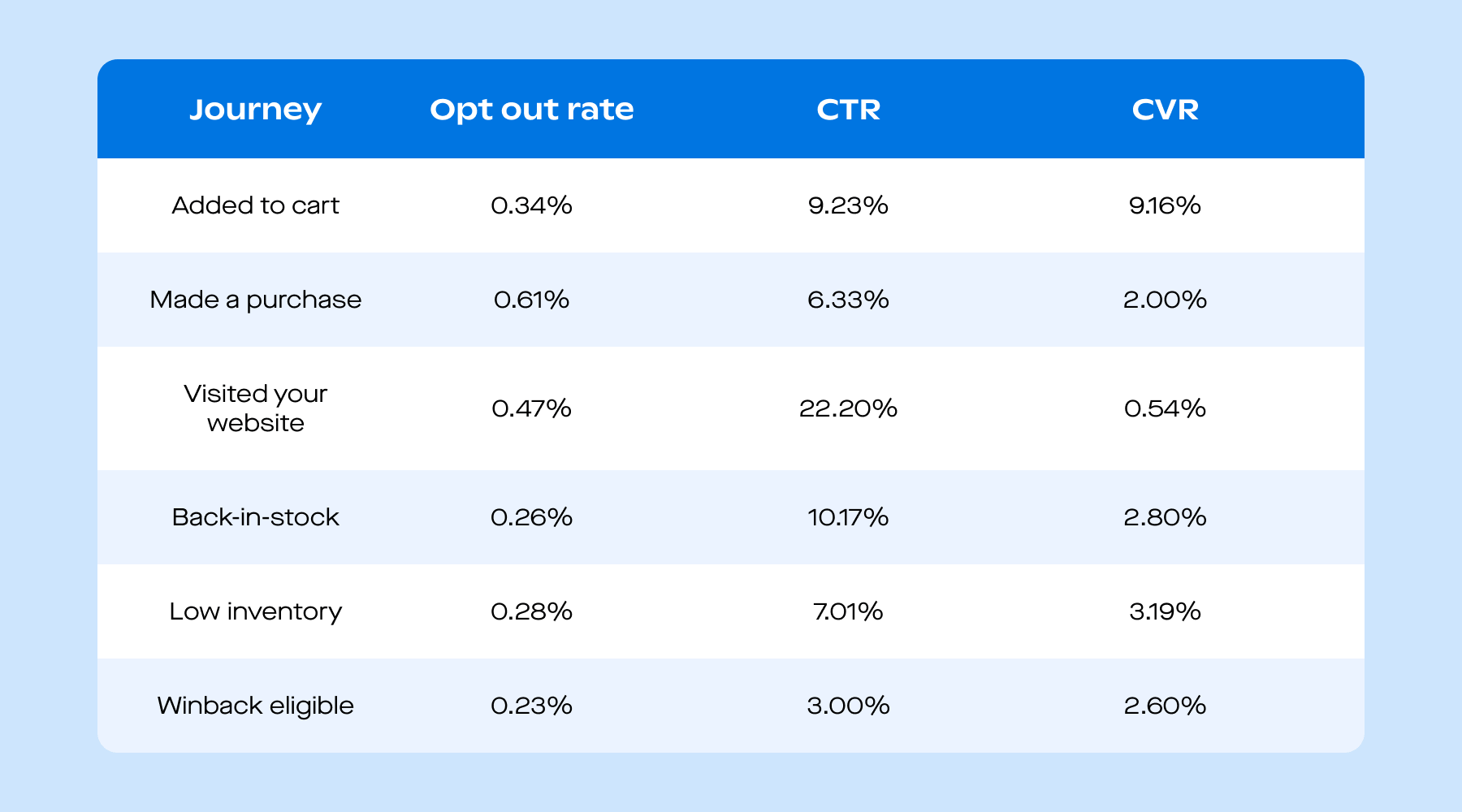
New releases
A smarter, simpler Attentive
Explore new features →
Explore new features →

Everyone's been talking about the same email marketing metrics for years. But in order to truly understand the success of your program, you need to be thinking about metrics from two perspectives—machine and human.
Before you analyze metrics from the perspective of how your human recipients responded to the message, you need to consider the impact that the machine had on the metrics. Analyzing them together will help fine-tune your strategy.
The first and most important machine metric is deliverability—the unsung hero of email marketing.
Most conversations around email marketing metrics start with things like open rates and click-through rates. But they should start with email deliverability. After all, if our emails aren’t being delivered or are going to the spam folder, how do we expect to accurately measure things like opens?
Deliverability is the measure of your emails’ ability to land in your recipients’ inboxes, and it’s the foundation of your email marketing strategy. Without it, all other metrics are just numbers on a page.
Many factors can impact email deliverability, including sender reputation, email content, and authentication protocols. Sender reputation, which is built over time based on your email sending practices, is a major factor in whether your emails are delivered to the inbox or marked as spam. Maintaining a positive sender reputation requires consistent and responsible email practices.
These variables are what mailbox providers look at when deciding if an email lands in the inbox or spam folder (don’t worry, we won’t let that happen). Let’s see what it takes to make sure your emails make it to the inbox.
Recency plays a significant role in determining whether an email lands successfully in the inbox. This time-based metric, which looks at how recently a subscriber engaged with your email, is a crucial factor for mailbox providers when evaluating sender reputation.
If subscribers engaged with your emails recently, it signals that they’re not only receptive to your email campaigns, but actively engaging with them.
This volume-based metric looks at how many attempts did you make to reach the recipient and get them to engage with your message. Recency looks at time and count of attempts looks at the number of sends.
Sending emails too infrequently can lead to your messages being treated as spam as the mailbox provider may not recognize your sending patterns. Conversely, bombarding subscribers with too many emails in a short span can result in fatigue and increased complaint rates, also negatively impacting deliverability. Consistency is the name of the game in email deliverability.
Persistently trying to contact unresponsive or invalid addresses can ruin your sender reputation, as mailbox providers may interpret this behavior as spam-like. Being interpreted as a spam-like sender can land you in the spam folder or cause messages to not get accepted by the mailbox provider at all (often referred to as bounces or blocks).
When subscribers actively open, click, and interact with your emails, it signals to mailbox providers that your content is valuable and relevant and needs to be delivered.
High engagement rates can boost your sender reputation, making it more likely that your emails will land in the inbox rather than the spam folder. On the other hand, low engagement—characterized by unopened emails or lack of clicks—can negatively impact deliverability, as mailbox providers may interpret this as a sign of irrelevance or poor content quality.
Did you know? Mailbox providers will recalibrate how they view your emails if a recipient moves an email from spam into their inbox.
With recent changes to email regulations, it's proof that spam filters aren't going to become more relaxed. Since April 1, 2024, Google and Yahoo have enforced changes regarding both the unsubscribe process and authentication.
Do not give the machines a reason to not trust the email you’re sending. Both marketers and the machines care about the subscriber. Understand that you’re up against spam filters, but by focusing on your shared customer and optimizing email for humans, you’ll optimize it for the machines at the same time.
When your email messages are sent to recipients that the machines view as "wanting that message," they will deliver it to the inbox. They simply look at engagement, frequency, and compliance to determine if your email is valuable to the human it’s being sent to. Here are some tips for making sure your email marketing campaigns will get delivered.
Essentially, if you’re not getting the most out of your email sends, it’s often down to three things: How you acquire addresses, how often you send, and when you choose to stop sending. Change one of these and you’ll get better results.
Outside of viewing your email metrics from the machine's perspective, there are a number of metrics that can help you understand how effective your email marketing campaigns are with the humans receiving them. This perspective on the following metrics can help you make decisions to improve your strategy and results.
Open rate is a key email marketing metric that shows you the percentage of recipients who opened your email. It’s a good measure of how effective your subject line was at getting people to open and read the email content. From the human perspective, a high open rate generally means that your subject lines are resonating with your audience and effectively communicating the value of your email.
Unique clicks tell you how many individual recipients clicked on links within your email. This metric can give you a sense of how engaging and relevant your email’s content is. A higher unique click rate means that your content is resonating with your recipients and is effectively driving them to take action.
Focus on unique click rate by domain. If any domain has a 100% click rate, it’d be wise to ignore those metrics since it is most likely a bot click that won't lead to conversions.
The ultimate goal of email marketing is, of course, conversion. They tell you how many recipients took the action you wanted them to take after engaging with your email. This could be making a purchase, signing up for a service, or downloading content. Your conversion rate is the number of conversions divided by the number of clicks. It’s a great way to see if your email is driving the results you want.
And then there's revenue per recipient (RPR), a key metric that showcases the financial impact of your email marketing. By dividing the total revenue from email campaigns by the number of emails delivered, you'll gain a clear picture of your return on investment (ROI) and the profitability of your email marketing strategy.
Improve your open rate, unique clicks, conversions, and RPR by following these best practices.
Remember, understanding and optimizing these metrics is a continuous process. Stay vigilant, experiment, and refine your strategies based on data-driven insights.
Another important consideration for your email program (that ties directly to the machines measuring your recency), is the type of email campaigns you’re sending. Email messages typically fall into two categories: campaigns or triggered messages (also known as journeys).
Campaigns are one-time messages that you can send on-demand or schedule in advance based on your marketing calendar. Due to their one-off nature, email campaigns are ideal for promoting time-sensitive offers, brand awareness plays, and driving retention with non-promotional content, such as product tips, announcements, User-Generated Content (UGC) such as reviews, or newsletters.
Triggered messages or journeys are sent when your subscribers do something, like leave their shopping cart, buy something, or not buy anything within a certain amount of time. Triggered email messages are designed to automatically nurture the brand-customer relationship at critical points in the customer lifecycle.
Optimize your journeys first to get the right number of emails and the right timing of those emails. We recommend about two to three emails per journey as these are often finite windows of time to capitalize on the recipient’s action. As for campaign sending, we don’t recommend sending a recipient more than four emails per week unless they are super engaged with your campaigns and open and click every single time.
Both of these email message types impact your email marketing metrics—both on the machine side and the human side.
Want to see how your metrics compare? We’ve compiled these email marketing benchmarks for our most popular journeys.

You should analyze your email marketing metrics regularly to ensure you’re making informed decisions that align with your strategic goals. After each campaign, a simple analysis should be done to look at the immediate performance indicators like open rates, click-through rates, and conversion rates.
For a more comprehensive understanding, a monthly review can provide insights into trends, campaign effectiveness over time, and audience behavior patterns.
Conducting a quarterly or bi-annual deep dive can help you adjust your long-term strategies, identify seasonal variations, and optimize your email marketing efforts for better engagement and conversions. Regular analysis not only helps in fine-tuning the campaigns but also in adapting to the changing preferences and behaviors of your target audience.
Whichever approach you take, the key is to consistently track your email marketing metrics over time. This allows you to compare the performance of different campaigns and make data-driven decisions about your strategy. By monitoring your metrics in the long term, you can identify patterns, optimize your content and design, and continuously improve your email marketing results.
Testing is a cornerstone of successful email marketing campaigns, providing valuable insights to improve performance and drive better results. By implementing A/B tests, you can compare different elements such as subject lines, content, send times, and calls-to-action to determine what resonates best with their your human audience. When your subscribers are engaging and clicking more, the machines will do their part to deliver your emails to those subscribers.
Regular testing not only ensures that campaigns remain relevant and engaging but also helps in making informed decisions that align with subscriber preferences and behaviors.
Being static will always make your program perform worse. You have to test your emails and make changes. If your email marketing campaigns stay the same, they’re actually getting worse.
No marketer lands in the inbox 100%, but by following the tips outlined here, you’ll have a strong email marketing strategy that both the machines and your human subscribers will like.
Looking to strengthen both your email and SMS channels? Stay tuned as we’ll dig into email and SMS attribution in an upcoming post.
In the meantime, if you’re looking for a marketing platform to unite your email and SMS channels, schedule a demo to learn how you drive more sales and save time with Attentive.